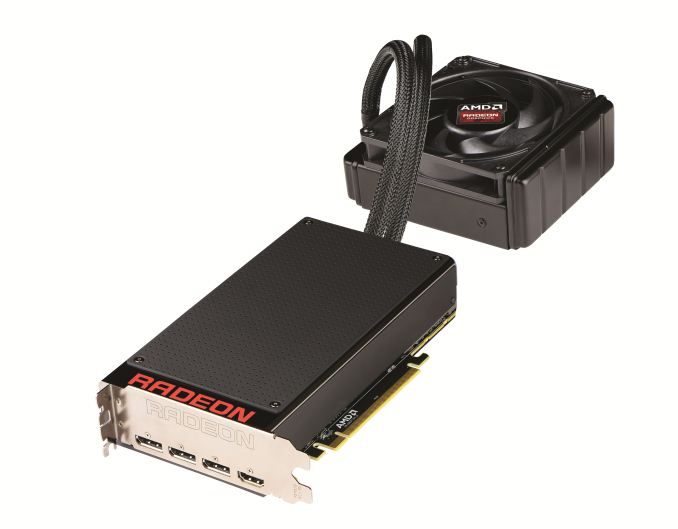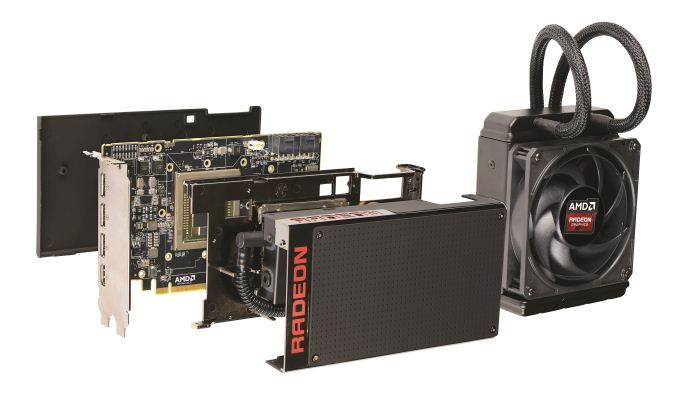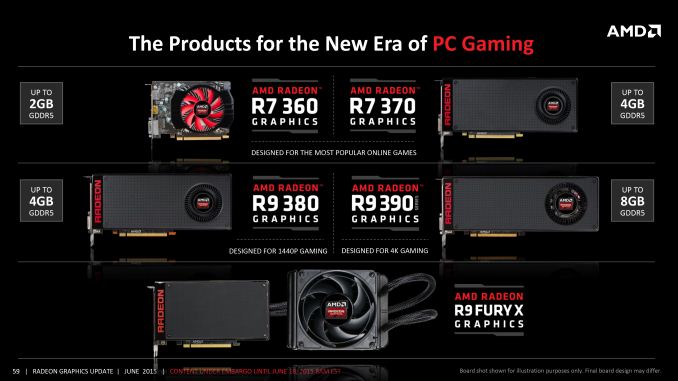AMD Launches Retail Radeon 300 Series: A Prelude To Fury
by Ryan Smith on June 18, 2015 10:35 AM EST- Posted in
- GPUs
- AMD
- Radeon
- Radeon 300

Throughout the last couple of months AMD has been in the process of carefully and deliberately rolling out their latest generation of video cards. In a multi-staged process we have seen AMD engage in a what is best described as a drawn-out teaser and an early technical briefing, announcing their intention to roll out a new high-end video card this quarter, further teasing the public with pictures of the card, and then in the middle of all of that giving the technical press an in-depth briefing on AMD’s key next-generation memory technology, High Bandwidth Memory. While AMD did their best to make sure the details of the cards were kept under wraps – with varying results – AMD definitely wanted to make sure the world would know that their card was coming.
Catching up to the present, earlier this week AMD held their 2015 GPU product showcase, dubbed “The New Era of PC Gaming.” As the latest stage in AMD’s master plan, AMD held a public event in Los Angeles similar to their 2014 GPU product showcase in Hawaii, where the company announced their product lineup ahead of the full launch of the products in question. In the presentation we learned some (but not all) of the details surrounding AMD’s Radeon 300 series, including the numbered products from 360 to 390, and of course the company’s new high-end flagship video card, the Radeon R9 Fury X.
All told the showcase itself was something of a teaser itself – we got prices, but not complete specifications – but we also received confirmation of AMD’s rollout plans. The next stage, coinciding with today’s article, is the formal launch of the numbered members of the Radeon 300 series, which are product refreshes based on existing AMD GPUs, similar to what we saw with the 200 series in 2013. Meanwhile today is also the greater unveiling (but not the launch) of the Fury series, with AMD allowing us to share more details about the new card and its specifications. Following today’s announcements and launches, the Radeon R9 Fury X will be launching in just under a week from now, on June 24th, and then after that the R9 Fury (vanilla) will be launching on July 14th.
| AMD R9 300 Series Specification Comparison | ||||||
| AMD Radeon R9 Fury X | AMD Radeon R9 Fury | AMD Radeon R9 390X | AMD Radeon R9 390 | |||
| Stream Processors | 4096 | (Fewer) | 2816 | 2560 | ||
| Texture Units | 256 | (How much) | 176 | 160 | ||
| ROPs | 64 | (Depnds) | 64 | 64 | ||
| Boost Clock | 1050MHz | (On Yields) | 1050MHz | 1000MHz | ||
| Memory Clock | 1Gbps HBM | (Memory Too) | 5Gbps GDDR5 | 5Gbps GDDR5 | ||
| Memory Bus Width | 4096-bit | 4096-bit | 512-bit | 512-bit | ||
| VRAM | 4GB | 4GB | 8GB | 8GB | ||
| FP64 | 1/16 | 1/16 | 1/8 | 1/8 | ||
| TrueAudio | Y | Y | Y | Y | ||
| Transistor Count | N/A | N/A | 6.2B | 6.2B | ||
| Typical Board Power | 275W | (High) | 275W | 275W | ||
| Manufacturing Process | TSMC 28nm | TSMC 28nm | TSMC 28nm | TSMC 28nm | ||
| Architecture | GCN 1.2 | GCN 1.2 | GCN 1.1 | GCN 1.1 | ||
| GPU | Fiji | Fiji | Hawaii | Hawaii | ||
| Launch Date | 06/24/15 | 07/14/15 | 06/18/15 | 06/18/15 | ||
| Launch Price | $649 | $549 | $429 | $329 | ||
Overall AMD is launching an almost top-to-bottom refresh of its product lineup overnight. Between now and July 14th the company and its partners will introduce cards from $109 to $649, and while there are a few gaps that AMD is almost certainly purposely leaving in place to give them something to announce later this year, overall we’re seeing more or less AMD’s entire hand for 2015 and early 2016 in one go.
As for the subjects at hand today, there are really two stories to talk about. The first is of course the Radeon R9 Fury series, the products that will house AMD’s newest flagship GPU, Fiji. While I won’t butter up Fiji from an architectural standpoint at this time, what Fiji does bring to the table are two very big changes for AMD. The first of these is of course high bandwidth memory, which not only gives AMD more VRAM bandwidth than ever before, but it outright changes how GPUs video cards are constructed. The second big change is that Fiji is just very big. At 596mm2 AMD went right to the reticle limit, putting AMD squarely into the big GPU race.
But before Fury comes the rest of the 300 series. We'll take a look at Fury in due time - while we've been briefed on the subject and have been authorized to discuss it, we want to hold back for when we have the hardware in hand - so our focus for today will be on what's launching today, and that's the Radeon 300 series.
Being released today are five new cards from AMD’s partners, which will form the backbone of the Radeon 300 series from $109 to $429. To our regular readers these parts will be familiar – and to some, perhaps more familiar than they’d like – while for AMD the 300 series represents their 3rd generation of retail 28nm products.













290 Comments
View All Comments
Jumangi - Thursday, June 18, 2015 - link
Talk about premature dude. We have not seen outside sites do comprehensive reviews on these cards and you already declare them the best. It would be foolish to spend money now without seeing how the high end cards do at 4K resolutions. AMD PR isn't worth much without legit numbers backing it up.FlushedBubblyJock - Sunday, June 21, 2015 - link
that's amazing - I'm at the 390/390X review spin, and instead of seeing amd lovers crooning over the new cards....they are squealing about fiji and fury
an there's 7+ pages of them doing it - not saying a word about 390 and 390x
that tells me how bad amd and it's fans are
I am astounded
fivefeet8 - Wednesday, June 24, 2015 - link
Wow. Someone's got egg somewhere.Chaser - Saturday, June 27, 2015 - link
How's that amazing performance looking now from other site's reviews? Anandtech was being honest with it's readers about these ridiculous re-brands. Now they are paying the price for their professionalism by telling it to their readers and not with AMD's spin.Fury X is a catchup to the 980ti with near zero overclocking room. Notice the sites that have Fury X reviews didn't grade overclocking? When Anandtech's review is out they most certainly will. So hardly a win. One model. All the rest are the same dated, overheating re-brands.
texasti89 - Thursday, June 18, 2015 - link
This new AMD release should be mainly judged by its efficiency or performance/watt metric. Of course AMD can double and triple transistor count to achieve a higher performance than that of the competitor, the real achievement is weather AMD engineers can attain that at a lower power budge, which I highly doubt is the case in this new generation given the push for water cooling. I would be very impressed if AMD can beat Maxwell efficiency in this release.nightbringer57 - Thursday, June 18, 2015 - link
At least on paper, they could.The Titan X performs around 40-50% better than the 290X in general (it depends heavily on the tests, as usual). Compared to the 290X, the fury X has around +40/50% more of everything (SP, Texturing units, memry bandwith) (except ROPs). The power consumption of the Titan X is not that far ahead of the 290X (around 10% less). So on paper, barring potential architectural performance changes per SP, barring the turbo behaviour that should be better with this cooling soltion, barring all factors... (again, it's a paper comparison), you end up with a card that has comparable performance with roughly 10% more power, which is quite decent.
The problem being that this performance/W level would not scale down very well, because you know, HBM. But a GTX980-esque R9 Fury "vanilla" could be possible.
Again, it's a paper comparison, we will see how it is on the 24th. But at least, there is some potential.
Gigaplex - Friday, June 19, 2015 - link
HBM would help it scale as HBM uses less power than GDDR5.nightbringer57 - Thursday, June 18, 2015 - link
And as a side note I forgot, I think the watercooling push on R9 fury models is simply due to the shorter PCB design (because, you know, HBM..), so if you don't want to lose this "advantage", you need a shorter radiator. Which may not be enough to cool down a good GPU. So you have to take some of the radiator off of the card, so you have to use watercooling unless you go for a 4-slots solution...looncraz - Thursday, June 18, 2015 - link
Have you actually seen the card? The radiator goes on a chassis exhaust port, NOT attached to the PCB...Unless, of course, you are calling a heatsink a radiator... and are actually referring to what would need to be done for air cooling (in which case you'd just go longer, not wider).
nightbringer57 - Thursday, June 18, 2015 - link
I don't know why, in my mind it was a hybrid air+water solution.In any case, it still follows the reasoning: when I say "taking some of the radiator off the card", it means that some (some being 100%) of the heatsink (radiateur in my baguette mother tongue, hence the confusion with "radiator", sorry) is not on the PCB anymore ;)